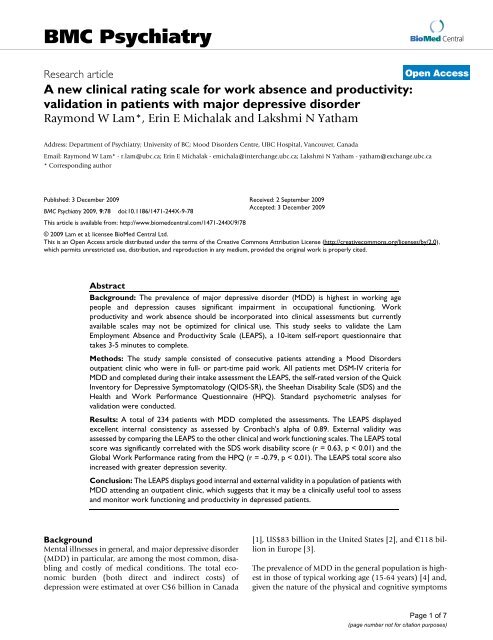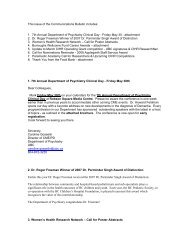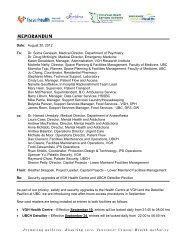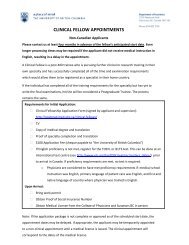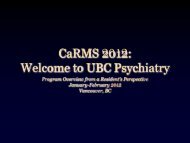Lam RW, Michalak EE, Yatham LN. A new clinical rating scale for ...
Lam RW, Michalak EE, Yatham LN. A new clinical rating scale for ...
Lam RW, Michalak EE, Yatham LN. A new clinical rating scale for ...
Create successful ePaper yourself
Turn your PDF publications into a flip-book with our unique Google optimized e-Paper software.
BMC Psychiatry<br />
BioMed Central<br />
Research article<br />
A <strong>new</strong> <strong>clinical</strong> <strong>rating</strong> <strong>scale</strong> <strong>for</strong> work absence and productivity:<br />
validation in patients with major depressive disorder<br />
Raymond W <strong>Lam</strong>*, Erin E <strong>Michalak</strong> and Lakshmi N <strong>Yatham</strong><br />
Open Access<br />
Address: Department of Psychiatry; University of BC; Mood Disorders Centre, UBC Hospital, Vancouver, Canada<br />
Email: Raymond W <strong>Lam</strong>* - r.lam@ubc.ca; Erin E <strong>Michalak</strong> - emichala@interchange.ubc.ca; Lakshmi N <strong>Yatham</strong> - yatham@exchange.ubc.ca<br />
* Corresponding author<br />
Published: 3 December 2009<br />
BMC Psychiatry 2009, 9:78 doi:10.1186/1471-244X-9-78<br />
This article is available from: http://www.biomedcentral.com/1471-244X/9/78<br />
Received: 2 September 2009<br />
Accepted: 3 December 2009<br />
© 2009 <strong>Lam</strong> et al; licensee BioMed Central Ltd.<br />
This is an Open Access article distributed under the terms of the Creative Commons Attribution License (http://creativecommons.org/licenses/by/2.0),<br />
which permits unrestricted use, distribution, and reproduction in any medium, provided the original work is properly cited.<br />
Abstract<br />
Background: The prevalence of major depressive disorder (MDD) is highest in working age<br />
people and depression causes significant impairment in occupational functioning. Work<br />
productivity and work absence should be incorporated into <strong>clinical</strong> assessments but currently<br />
available <strong>scale</strong>s may not be optimized <strong>for</strong> <strong>clinical</strong> use. This study seeks to validate the <strong>Lam</strong><br />
Employment Absence and Productivity Scale (LEAPS), a 10-item self-report questionnaire that<br />
takes 3-5 minutes to complete.<br />
Methods: The study sample consisted of consecutive patients attending a Mood Disorders<br />
outpatient clinic who were in full- or part-time paid work. All patients met DSM-IV criteria <strong>for</strong><br />
MDD and completed during their intake assessment the LEAPS, the self-rated version of the Quick<br />
Inventory <strong>for</strong> Depressive Symptomatology (QIDS-SR), the Sheehan Disability Scale (SDS) and the<br />
Health and Work Per<strong>for</strong>mance Questionnaire (HPQ). Standard psychometric analyses <strong>for</strong><br />
validation were conducted.<br />
Results: A total of 234 patients with MDD completed the assessments. The LEAPS displayed<br />
excellent internal consistency as assessed by Cronbach's alpha of 0.89. External validity was<br />
assessed by comparing the LEAPS to the other <strong>clinical</strong> and work functioning <strong>scale</strong>s. The LEAPS total<br />
score was significantly correlated with the SDS work disability score (r = 0.63, p < 0.01) and the<br />
Global Work Per<strong>for</strong>mance <strong>rating</strong> from the HPQ (r = -0.79, p < 0.01). The LEAPS total score also<br />
increased with greater depression severity.<br />
Conclusion: The LEAPS displays good internal and external validity in a population of patients with<br />
MDD attending an outpatient clinic, which suggests that it may be a <strong>clinical</strong>ly useful tool to assess<br />
and monitor work functioning and productivity in depressed patients.<br />
Background<br />
Mental illnesses in general, and major depressive disorder<br />
(MDD) in particular, are among the most common, disabling<br />
and costly of medical conditions. The total economic<br />
burden (both direct and indirect costs) of<br />
depression were estimated at over C$6 billion in Canada<br />
[1], US$83 billion in the United States [2], and €118 billion<br />
in Europe [3].<br />
The prevalence of MDD in the general population is highest<br />
in those of typical working age (15-64 years) [4] and,<br />
given the nature of the physical and cognitive symptoms<br />
Page 1 of 7<br />
(page number not <strong>for</strong> citation purposes)
BMC Psychiatry 2009, 9:78<br />
http://www.biomedcentral.com/1471-244X/9/78<br />
of depression, it is not surprising that the major portion of<br />
the economic burden of MDD arises from impairment in<br />
occupational functioning. Numerous studies have documented<br />
that <strong>clinical</strong> depression is associated with high<br />
rates of absenteeism, or time away from work. For example,<br />
depressed workers in the United States reported 1.5-<br />
3.2 more short-term work-disability days per month,<br />
compared to people who were not depressed [5], while a<br />
Canadian study found that approximately 2.5% of<br />
employees in 3 large companies had at least 1 depressionrelated<br />
short-term disability leave [6]. Similarly, in the<br />
European ESEMeD study, depressed workers had 3-4<br />
times more work-loss days per month than those without<br />
depression [7].<br />
While the economic costs of depression-related absenteeism<br />
are significant, they are dwarfed by those attributed to<br />
presenteeism, in which depressed workers stay at work but<br />
have reduced productivity as a result of their condition. In<br />
a community survey in Canada, 29% of people with a history<br />
of MDD in the past year reported reduced activities at<br />
work, compared to only 10% of people with no history of<br />
depression [8]. Almost half of people with chronic depression<br />
reported reduced productivity at work [9] and the<br />
costs of productivity losses associated with MDD have<br />
been estimated in the United States (in 2002) at over<br />
US$31 billion [10].<br />
Given the magnitude of occupational impairment in<br />
MDD, it is important to include assessment of work functioning<br />
within the <strong>clinical</strong> evaluation and management of<br />
the condition. There are many validated <strong>scale</strong>s used to<br />
measure work per<strong>for</strong>mance and productivity, including<br />
generic productivity <strong>scale</strong>s (e.g., Work Limitations Questionnaire<br />
[11], Stan<strong>for</strong>d Presenteeism Scale [12]) that are<br />
useful <strong>for</strong> comparisons with other disease conditions.<br />
However, there are few work per<strong>for</strong>mance <strong>scale</strong>s designed<br />
specifically <strong>for</strong> use in a depressed population. A rationale<br />
<strong>for</strong> using disease-specific measures includes the potential<br />
<strong>for</strong> such <strong>scale</strong>s to provide more specific in<strong>for</strong>mation that<br />
might otherwise be missed or to be more sensitive to<br />
change than generic counterparts [13]. For example, a<br />
depression-specific <strong>scale</strong> <strong>for</strong> work functioning may prove<br />
useful as a <strong>clinical</strong> tool <strong>for</strong> monitoring progress during<br />
treatment and/or as an outcome measure in <strong>clinical</strong> trials<br />
<strong>for</strong> MDD. This study seeks to validate a <strong>new</strong> <strong>clinical</strong> <strong>rating</strong><br />
<strong>scale</strong> <strong>for</strong> work functioning and productivity in patients<br />
with MDD.<br />
Methods<br />
Scale Development<br />
The <strong>Lam</strong> Employment Absence and Productivity Scale<br />
(LEAPS) was designed to assess work functioning and<br />
impairment in a <strong>clinical</strong>ly depressed population. The<br />
items were constructed and selected based on a review of<br />
the literature on depressive symptoms and interference<br />
with work functioning, and on the common work-related<br />
problems experienced by people with depression.<br />
The LEAPS (Additional file 1) is a self-rated questionnaire<br />
consisting of 10 items: the first item asks the respondent<br />
to list their occupation and the next two items ask about<br />
the number of work hours scheduled in the past two<br />
weeks and the number of work hours missed. These items<br />
assess absenteeism, which can be expressed as a proportion<br />
(%) of work hours scheduled. Finally, there are 7<br />
items rated on a 5-point Likert <strong>scale</strong> with the following<br />
response <strong>for</strong>mat: 'None of the time (0%)', 'Some of the<br />
time (25%)', 'Half the time (50%)', 'Most of the time<br />
(75%)', 'All the time (100%)', scored as 0-4, respectively.<br />
The LEAPS total score there<strong>for</strong>e ranges from 0 to 28. A<br />
"productivity sub<strong>scale</strong>" sums the scores from the 3 items<br />
assessing work functioning and productivity (doing less<br />
work, doing poor quality work, and making more mistakes).<br />
Subjects and Procedures<br />
The validation sample consisted of consecutive patients<br />
with MDD attending a Mood Disorders clinic at a university<br />
teaching hospital. Patients were referred from primary<br />
care physicians and from community psychiatrists. Clinical<br />
assessments were conducted by board-certified psychiatrists.<br />
Diagnoses were assigned according to DSM-IV<br />
criteria based on <strong>clinical</strong> interviews supplemented by a<br />
symptom check list and all available medical in<strong>for</strong>mation.<br />
Inclusion criteria <strong>for</strong> this study included a DSM-IV diagnosis<br />
of MDD; patients with bipolar disorder were<br />
excluded. Patients also had to be working, defined as paid<br />
work (employed or self-employed), either part-time or<br />
full-time. Patients on short-term or long-term work disability<br />
were excluded. This study was approved by the Clinical<br />
Research Ethics Board of the University of British<br />
Columbia.<br />
Patients completed several questionnaires at initial assessment,<br />
including the Quick Inventory of Depressive Symptomatology,<br />
Self-Rated (QIDS-SR), a validated and widely<br />
used self-rated <strong>scale</strong> to assess severity and type of depressive<br />
symptoms [14]. In addition, subjects completed the<br />
Health and Work Per<strong>for</strong>mance Questionnaire (HPQ,<br />
[15]) and the Sheehan Disability Scale (SDS, [16]). The<br />
HPQ was developed <strong>for</strong> the World Health Organization as<br />
a depression-specific, self-rated questionnaire that<br />
assesses illness-related work absence (as number of hours/<br />
week), work productivity, Global Work Per<strong>for</strong>mance, and<br />
job-related accidents. The HPQ has been validated against<br />
objective measures of absence and per<strong>for</strong>mance in a<br />
number of blue-collar and white-collar occupations<br />
[17,18] and can be considered the "gold standard" productivity<br />
assessment. The SDS is a generic self-report<br />
Page 2 of 7<br />
(page number not <strong>for</strong> citation purposes)
BMC Psychiatry 2009, 9:78<br />
http://www.biomedcentral.com/1471-244X/9/78<br />
inventory that assesses the degree to which symptoms<br />
have disrupted the person's work, social life, and family<br />
life. A single question assesses work/school impairment,<br />
<strong>for</strong>matted as 'The symptoms have disrupted your work/<br />
school work:' and rated on a 0-10 point <strong>scale</strong> ranging from<br />
'Not at all (0)' through 'Mildly (1-3)', 'Moderately (4-6)'<br />
and 'Markedly (7-9)' to 'Extremely (10)'. There are two<br />
additional items which inquire about the number of days<br />
lost in the past month owing to absence or reduced productivity.<br />
Statistical Procedures<br />
All results are reported as means ± standard deviations<br />
(SD). Construct validation of a <strong>scale</strong> <strong>for</strong> work functioning<br />
is complex because there are no definitive measures <strong>for</strong><br />
the underlying construct. Hence, we conducted a series of<br />
<strong>scale</strong> validation procedures. Internal consistency (the<br />
degree to which the items of a <strong>scale</strong> measure the same construct)<br />
of the 7 LEAPS items was measured using Cronbach's<br />
alpha. To assess the structure of the LEAPS, a factor<br />
analysis was conducted using Principal Components Analysis<br />
with varimax rotation. Convergent validity is the degree<br />
of correlation between a <strong>new</strong> <strong>scale</strong> and previously validated<br />
measures of the same construct. This was assessed<br />
using two-tailed Pearson correlations between the LEAPS<br />
total score and scores on other <strong>scale</strong>s measuring work productivity.<br />
In addition, work functioning would be<br />
expected to be more impaired as the depressive symptomatology<br />
worsens. There<strong>for</strong>e, the LEAPS should discriminate<br />
between severity categories (e.g., minimally<br />
depressed versus more severely depressed) of depression.<br />
This was evaluated by examining mean scores on the<br />
LEAPS across the range of severity categories of the QIDS-<br />
SR, using one-way ANOVA. If the overall F was significant,<br />
post hoc pairwise comparisons between severity categories<br />
were examined using Tukey's HSD to control <strong>for</strong> multiple<br />
comparisons. All statistical analyses were conducted<br />
using SPSS, V.16 [19].<br />
Results<br />
Subject Demographic Variables<br />
Table 1 shows the demographic and <strong>clinical</strong> in<strong>for</strong>mation<br />
<strong>for</strong> the 234 subjects studied. The profile is typical of a<br />
mood disorders cohort attending a specialty clinic. The<br />
mean score on the QIDS-SR was 13.8 ± 5.9, indicating a<br />
moderate severity of depression. The subjects missed an<br />
average of 10 hours of work in the past 2 weeks owing to<br />
their symptoms, which represented 16% of the time they<br />
were scheduled to work.<br />
Internal Consistency<br />
The Cronbach's alpha <strong>for</strong> the 7 Likert-scored items on the<br />
LEAPS was 0.89, indicating that the LEAPS items showed<br />
high internal consistency.<br />
Factor Analysis<br />
Table 2 shows the results of the factor analysis with varimax<br />
rotation conducted on the 7 Likert-scored items of<br />
the LEAPS. Two factors were identified on the Principal<br />
Components Analysis that accounted <strong>for</strong> 75% of the variance<br />
in the LEAPS total score. The first factor included the<br />
3 items relating to work productivity, which accounted <strong>for</strong><br />
60% of the variance. The second factor comprised the 4<br />
items relating to troublesome symptoms, which<br />
accounted <strong>for</strong> an additional 15% of the variance.<br />
Convergent Validity<br />
Table 3 shows the Pearson correlation matrix <strong>for</strong> the<br />
LEAPS total score and the productivity sub<strong>scale</strong> score with<br />
other work functioning and productivity measures. There<br />
Table 1: Demographic and <strong>clinical</strong> features of the validation sample (N = 234).<br />
Variable<br />
Mean ± SD<br />
Age (years) 39.2 ± 11.7<br />
Marital status (% of sample) (married/single/divorced/separated) 43/34/14/9<br />
Number of episodes 2.5 ± 4.3<br />
Duration of current episode (months) 6.9 ± 8.9<br />
QIDS-SR score 13.8 ± 5.9<br />
Number of hours in the past 2 weeks scheduled or expected to work 60.3 ± 22.4<br />
Number of hours in the past 2 weeks missed from work 10.2 ± 17.8<br />
% of work hours missed (per hours scheduled) 16.2% ± 27.0%<br />
SD, standard deviation; QIDS-SR, Quick Inventory of Depressive Symptomatology, Self-Rated.<br />
Page 3 of 7<br />
(page number not <strong>for</strong> citation purposes)
BMC Psychiatry 2009, 9:78<br />
http://www.biomedcentral.com/1471-244X/9/78<br />
Table 2: Factor loadings of the 7 items on the LEAPS (Principal Components Analysis, using varimax rotation).<br />
LEAPS Item Factor 1 (Work productivity) Factor 2 (Troublesome Symptoms)<br />
Low energy or motivation 0.40 0.72<br />
Poor concentration or memory 0.28 0.78<br />
Anxiety or irritability 0.23 0.82<br />
Getting less work done 0.73 0.46<br />
Doing poor quality work 0.85 0.31<br />
Making more mistakes 0.90 0.10<br />
Having trouble getting along with people, or avoiding them 0.15 0.86<br />
LEAPS, <strong>Lam</strong> Employment Absence and Productivity Scale.<br />
were significant correlations between the scores with all<br />
the other measures, including a high correlation with the<br />
"gold standard" HPQ Global Work Per<strong>for</strong>mance <strong>rating</strong>.<br />
Only a moderate correlation was found with the SDS<br />
Work score, likely explained by the fact the SDS score is<br />
comprised of a single item. The LEAPS total score and<br />
work productivity sub<strong>scale</strong> score also explained more of<br />
the variance with '% hours of work missed' than either the<br />
SDS Work score (r = 0.24) or the HPQ Global Work Per<strong>for</strong>mance<br />
score (r = -0.37).<br />
Discrimination Between Depression Severity Categories<br />
Table 4 shows the mean scores on the LEAPS <strong>for</strong> each of<br />
the severity categories of the QIDS-SR depressive symptom<br />
<strong>scale</strong>. There were significant differences in the LEAPS<br />
total scores overall (one-way ANOVA: F = 47.4, df = 4,229,<br />
p < 0.01). Post hoc Tukey's HSD tests showed significant<br />
differences (p < 0.05) between each pairwise comparison,<br />
except between the Severe and Very Severe categories. Similar<br />
results were seen with the LEAPS productivity sub<strong>scale</strong><br />
scores.<br />
Figure 1 shows the degree of <strong>clinical</strong> impairment (defined<br />
as percentage of the sample scoring 2 or higher on the<br />
item, indicating 50% or more of the time) in the individual<br />
productivity items associated with depression severity<br />
categories (as defined by the QIDS-SR scores).<br />
Discussion<br />
The results from this validation study suggest that the psychometric<br />
properties of the LEAPS are very good. The<br />
LEAPS demonstrated a high internal consistency as measured<br />
by Cronbach's alpha. The factor analysis of the<br />
LEAPS showed that it is comprised of two factors, termed<br />
Work Productivity and Troublesome Symptoms, which<br />
account <strong>for</strong> a large proportion of the variance in total<br />
scores.<br />
The validity of the LEAPS was further supported by the significant<br />
correlations with other validated measures of<br />
work functioning and productivity, including the SDS and<br />
the HPQ. Only a moderate correlation (explaining 40% of<br />
the variance) between the LEAPS and the SDS was<br />
observed, which is to be expected given that the SDS Work<br />
score is comprised of only a single item, compared to the<br />
higher correlation (explaining over 60% of the variance)<br />
found with the HPQ. The LEAPS score also showed higher<br />
correlations with the '% of work hours missed' over a 2-<br />
Table 3: Pearson correlations of LEAPS scores with other work functioning and productivity measures.<br />
LEAPS score SDS-Work HPQ Global Work<br />
Per<strong>for</strong>mance<br />
HPQ Productivity<br />
(4 items)<br />
% of work hours missed in the<br />
past 2 weeks<br />
Total Score* 0.63 -0.79 -0.70 0.41<br />
Work productivity sub<strong>scale</strong> (3<br />
items) score*<br />
0.50 -0.85 -0.77 0.45<br />
LEAPS, <strong>Lam</strong> Employment Absence and Productivity Scale; SDS-Work, Sheehan Disability Scale, Work item; HPQ, Health and Work Per<strong>for</strong>mance<br />
Questionnaire.<br />
*All correlations are significant at p < 0.01.<br />
Page 4 of 7<br />
(page number not <strong>for</strong> citation purposes)
BMC Psychiatry 2009, 9:78<br />
http://www.biomedcentral.com/1471-244X/9/78<br />
Table 4: Mean scores on the LEAPS total and Productivity Sub<strong>scale</strong> versus depression severity (based on QIDS-SR score).<br />
QIDS-SR Severity Category (score range) N LEAPS total score* SD LEAPS Productivity Sub<strong>scale</strong> score* SD<br />
None to minimal (0-5) 25 2.6 2.3 0.6 0.9<br />
Mild (6-10) 41 8.4 4.6 2.9 2.1<br />
Moderate (11-15) 78 13.1 4.6 4.8 2.7<br />
Severe (16-20) 57 15.7 5.7 6.6 3.2<br />
Very Severe (21-27) 33 18.2 6.7 5.9 4.4<br />
Total 234 12.5 6.8 4.6 3.4<br />
QIDS-SR, Quick Inventory of Depressive Symptomatology, Self-Rated; LEAPS, <strong>Lam</strong> Employment Absence and Productivity Scale; SD, standard<br />
deviation.<br />
* p < 0.05, one-way ANOVA using post hoc Tukey's Highly Significant Differences <strong>for</strong> all pairwise comparisons, except between Severe and Very<br />
Severe categories.<br />
week period than the SDS Work score and the HPQ Global<br />
Work Per<strong>for</strong>mance <strong>rating</strong>.<br />
The LEAPS scores also increase significantly with increasing<br />
overall severity of depressive symptoms and can discriminate<br />
between various depression severity categories,<br />
such as between 'None to minimal' and more severely<br />
depressed categories. The results from the individual productivity<br />
items on the LEAPS indicate that significant<br />
work impairment is found in patients with MDD. More<br />
than 75% of patients with higher severity of depressive<br />
symptoms described problems "much of the time" or "all<br />
the time" with the quantity and quality of work. In addition<br />
to productivity loss, the LEAPS data show that<br />
depressed patients were absent from work <strong>for</strong> 16% of their<br />
scheduled work hours (over 1.5 typical working days) in<br />
the previous two weeks. This is of similar magnitude to<br />
findings from other studies of work absence [5,7] and<br />
illustrates the substantial impact of depression on absenteeism.<br />
Although the LEAPS per<strong>for</strong>ms well in this population, the<br />
limitations of this study need to be acknowledged. Further<br />
studies are needed to validate the LEAPS against external<br />
and objective measures of work per<strong>for</strong>mance, such as<br />
employer work absence data and objective measures of<br />
productivity. However, other studies have shown that selfrated<br />
work productivity measures are significantly correlated<br />
with objective metrics [20,21] and with administrative<br />
work records [15]. In addition, further studies are<br />
required to investigate the per<strong>for</strong>mance of the LEAPS in<br />
non-<strong>clinical</strong> samples of workers and in other <strong>clinical</strong> populations<br />
in specialist and primary care settings.<br />
Clinical treatment studies in MDD now focus on symptom<br />
remission because of the evidence <strong>for</strong> poor outcomes<br />
predicted by the presence of residual depressive symptoms<br />
[22]. However, functional improvement, including<br />
that of work functioning, is more relevant to patients and<br />
restoration of occupational functioning is important to<br />
society [23]. The concept of measurement-based care <strong>for</strong><br />
depression [24], in which outcomes are assessed using<br />
validated <strong>scale</strong>s and which is increasingly recommended<br />
by <strong>clinical</strong> guidelines <strong>for</strong> the management of MDD [25],<br />
should encompass work functioning as well as symptom<br />
severity.<br />
Many of the validated <strong>scale</strong>s that assess work functioning<br />
are "generic" in that they are designed to evaluate productivity<br />
across a wide range of non-specific medical conditions.<br />
Alternatively, a disease-specific <strong>scale</strong> can provide<br />
important in<strong>for</strong>mation <strong>for</strong> a defined <strong>clinical</strong> population.<br />
There are few depression-specific productivity <strong>scale</strong>s available.<br />
The HPQ is the "gold standard" <strong>scale</strong> <strong>for</strong> assessment<br />
of work per<strong>for</strong>mance in patients with depression, but at<br />
37 items and 8 pages in length, the respondent burden<br />
may be too high <strong>for</strong> routine <strong>clinical</strong> use. In contrast, the<br />
LEAPS is short (10 items on a single page) and simple and<br />
takes only 3-5 minutes to complete. Its brevity suggests<br />
that it will be an efficient tool <strong>for</strong> use in <strong>clinical</strong> settings.<br />
For example, the LEAPS can be used alongside symptom<br />
<strong>scale</strong>s to monitor treatment progress, to ensure that work<br />
functioning improves in parallel with <strong>clinical</strong> symptoms.<br />
Additionally, scores on individual items (e.g., making<br />
mistakes) can be used to in<strong>for</strong>m discussions with<br />
depressed workers regarding whether to stay at work or<br />
take time off while being treated <strong>for</strong> MDD.<br />
Page 5 of 7<br />
(page number not <strong>for</strong> citation purposes)
BMC Psychiatry 2009, 9:78<br />
http://www.biomedcentral.com/1471-244X/9/78<br />
Minimally depressed (N=25)<br />
Mildly depressed (N=41)<br />
Moderately depressed (N=78)<br />
Severely depressed (N=57)<br />
Very Severely depressed (N=33)<br />
Percentage of sample<br />
endorsing 50% or<br />
more of the time…<br />
Getting less<br />
work done<br />
Doing poor<br />
quality work<br />
Making more<br />
mistakes<br />
LEAPS Work Productivity Items<br />
Significant Figure 1 impairment in work productivity items (from the LEAPS) versus depression severity (based on QIDS-SR score)<br />
Significant impairment in work productivity items (from the LEAPS) versus depression severity (based on<br />
QIDS-SR score).<br />
The productivity impairment measured by the LEAPS<br />
increases, as expected, with increasing severity of depression.<br />
Although this is a cross-sectional observation, it suggests<br />
that the <strong>scale</strong> may also be useful as an outcome<br />
measure <strong>for</strong> occupational functioning in <strong>clinical</strong> trials of<br />
MDD. Further studies are underway to investigate the utility<br />
of the LEAPS to assess change in work functioning with<br />
treatment of MDD.<br />
Conclusion<br />
The LEAPS is a short and simple self-rated <strong>scale</strong> of work<br />
absence and productivity that has been designed <strong>for</strong> use in<br />
a <strong>clinical</strong>ly depressed population. It displays good internal<br />
and external validity compared to other validated, selfrated<br />
<strong>scale</strong>s of work per<strong>for</strong>mance and productivity. Further<br />
studies will be needed to determine whether the<br />
LEAPS can be used in other populations or as an outcome<br />
measure <strong>for</strong> <strong>clinical</strong> trials, and whether it will prove useful<br />
as a <strong>clinical</strong> tool to assess and monitor occupational functioning<br />
in patients with MDD.<br />
Competing interests<br />
<strong>RW</strong>L has received honoraria <strong>for</strong> consulting/speaking<br />
from: Advanced Neuromodulation Systems Inc., Astra-<br />
Zeneca, Biovail, Canadian Network <strong>for</strong> Mood and Anxiety<br />
Treatments, Eli Lilly, Janssen, Litebook Company Ltd.,<br />
Lundbeck, Lundbeck Institute, Servier, Takeda, and<br />
Wyeth. He has received research grants from: Advanced<br />
Neuromodulation Systems Inc., AstraZeneca, BrainCells<br />
Inc., Canadian Institutes of Health Research, Canadian<br />
Psychiatric Research Foundation, Litebook Company Ltd.,<br />
Lundbeck, Mathematics of In<strong>for</strong>mation Technology and<br />
Advanced Computing Systems, Michael Smith Foundation<br />
<strong>for</strong> Health Research, Servier, and UBC Institute of<br />
Mental Health/Coast Capital Savings. He holds a copyright<br />
on the LEAPS.<br />
<strong>EE</strong>M declares that she has no competing interests.<br />
<strong>LN</strong>Y has received honoraria <strong>for</strong> consulting/speaking from:<br />
AstraZeneca, Bristol Myers Squibb, Canadian Network <strong>for</strong><br />
Mood and Anxiety Treatments, GlaxoSmithKline, Janssen,<br />
Pfizer, Ranbaxy, and Scherring Plough. He has received<br />
research grants from: AstraZeneca, Bristol Myers Squibb,<br />
Canadian Institutes of Health Research, Janssen, Michael<br />
Smith Foundation <strong>for</strong> Health Research, Servier, and<br />
Stanley Foundation.<br />
Authors' contributions<br />
<strong>RW</strong>L conceived the study, designed the <strong>scale</strong>, contributed<br />
to data acquisition, conducted the statistical analysis,<br />
interpreted the data, wrote the initial draft of the manuscript,<br />
and funded the study through internal research<br />
funds. <strong>EE</strong>M contributed to study design and data acquisition,<br />
interpreted the data, and revised drafts of the manuscript.<br />
<strong>LN</strong>Y contributed to study design and data<br />
acquisition, interpreted the data, and revised drafts of the<br />
manuscript. All authors read and approved the final manuscript.<br />
Page 6 of 7<br />
(page number not <strong>for</strong> citation purposes)
BMC Psychiatry 2009, 9:78<br />
http://www.biomedcentral.com/1471-244X/9/78<br />
Additional material<br />
Additional file 1<br />
The LEAPS. The self-rated questionnaire consisting of 10 items that was<br />
used in the study.<br />
Click here <strong>for</strong> file<br />
[http://www.biomedcentral.com/content/supplementary/1471-<br />
244X-9-78-S1.PDF]<br />
Acknowledgements<br />
The authors would like to acknowledge their appreciation to the patients<br />
attending the Mood Disorders Centre, UBC Hospital, <strong>for</strong> their participation<br />
in this study. Erin <strong>Michalak</strong> is supported by a Michael Smith Scholar<br />
Award from the Michael Smith Foundation <strong>for</strong> Health Research and a New<br />
Investigator Award from the Canadian Institutes <strong>for</strong> Health Research.<br />
References<br />
1. Stephens T, Joubert N: The economic burden of mental health<br />
problems in Canada. Chronic Dis Can 2001, 22:18-23.<br />
2. Greenberg PE, Kessler RC, Birnbaum HG, Leong SA, Lowe SW, Berglund<br />
PA, Corey-Lisle PK: The economic burden of depression<br />
in the United States: how did it change between 1990 and<br />
2000 J Clin Psychiatry 2003, 64:1465-1475.<br />
3. Sobocki P, Jonsson B, Angst J, Rehnberg C: Cost of depression in<br />
Europe. J Ment Health Policy Econ 2006, 9:87-98.<br />
4. Patten SB, Wang JL, Williams JV, Currie S, Beck CA, Maxwell CJ, el<br />
Guebaly N: Descriptive epidemiology of major depression in<br />
Canada. Can J Psychiatry 2006, 51:84-90.<br />
5. Kessler RC, Barber C, Birnbaum HG, Frank RG, Greenberg PE, Rose<br />
RM, Simon GE, Wang P: Depression in the workplace: effects on<br />
short-term disability. Health Aff (Millwood) 1999, 18:163-171.<br />
6. Dewa CS, Goering P, Lin E, Paterson M: Depression-related<br />
short-term disability in an employed population. J Occup Environ<br />
Med 2002, 44:628-633.<br />
7. Alonso J, Angermeyer MC, Bernert S, Bruffaerts R, Brugha TS, Bryson<br />
H, de Girolamo G, Graaf R, Demyttenaere K, Gasquet I, Haro JM,<br />
Katz SJ, Kessler RC, Kovess V, Lepine JP, Ormel J, Polidori G, Russo<br />
LJ, Vilagut G, Almansa J, Arbabzadeh-Bouchez S, Autonell J, Bernal M,<br />
Buist-Bouwman MA, Codony M, Domingo-Salvany A, Ferrer M, Joo<br />
SS, Martinez-Alonso M, Matschinger H, Mazzi F, Morgan Z, Morosini<br />
P, Palacin C, Romera B, Taub N, Vollebergh WA: Disability and<br />
quality of life impact of mental disorders in Europe: results<br />
from the European Study of the Epidemiology of Mental Disorders<br />
(ESEMeD) project. Acta Psychiatr Scand Suppl 2004:38-46.<br />
8. Gilmour H, Patten SB: Depression and work impairment. Health<br />
Rep 2007, 18:9-22.<br />
9. Druss BG, Schlesinger M, Allen HM Jr: Depressive symptoms, satisfaction<br />
with health care, and 2-year work outcomes in an<br />
employed population. Am J Psychiatry 2001, 158:731-734.<br />
10. Stewart WF, Ricci JA, Chee E, Hahn SR, Morganstein D: Cost of lost<br />
productive work time among US workers with depression.<br />
JAMA 2003, 289:3135-3144.<br />
11. Lerner D, Amick BC III, Rogers WH, Malspeis S, Bungay K, Cynn D:<br />
The Work Limitations Questionnaire. Med Care 2001,<br />
39:72-85.<br />
12. Koopman C, Pelletier KR, Murray JF, Sharda CE, Berger ML, Turpin<br />
RS, Hackleman P, Gibson P, Holmes DM, Bendel T: Stan<strong>for</strong>d presenteeism<br />
<strong>scale</strong>: health status and employee productivity. J<br />
Occup Environ Med 2002, 44:14-20.<br />
13. <strong>Michalak</strong> <strong>EE</strong>, Murray G, Young AH, <strong>Lam</strong> <strong>RW</strong>: Burden of bipolar<br />
depression: impact of disorder and medications on quality of<br />
life. CNS Drugs 2008, 22:389-406.<br />
14. Rush AJ, Trivedi MH, Ibrahim HM, Carmody TJ, Arnow B, Klein DN,<br />
Markowitz JC, Ninan PT, Kornstein S, Manber R, Thase ME, Kocsis<br />
JH, Keller MB: The 16-Item Quick Inventory of Depressive<br />
Symptomatology (QIDS), clinician <strong>rating</strong> (QIDS-C), and selfreport<br />
(QIDS-SR): a psychometric evaluation in patients<br />
with chronic major depression. Biol Psychiatry 2003, 54:573-583.<br />
15. Kessler RC, Barber C, Beck A, Berglund P, Cleary PD, McKenas D,<br />
Pronk N, Simon G, Stang P, Ustun TB, Wang P: The World Health<br />
Organization Health and Work Per<strong>for</strong>mance Questionnaire<br />
(HPQ). J Occup Environ Med 2003, 45:156-174.<br />
16. Leon AC, Olfson M, Portera L, Farber L, Sheehan DV: Assessing<br />
psychiatric impairment in primary care with the Sheehan<br />
Disability Scale. Int J Psychiatry Med 1997, 27:93-105.<br />
17. Kessler RC, Ames M, Hymel PA, Loeppke R, McKenas DK, Richling<br />
DE, Stang PE, Ustun TB: Using the World Health Organization<br />
Health and Work Per<strong>for</strong>mance Questionnaire (HPQ) to<br />
evaluate the indirect workplace costs of illness. J Occup Environ<br />
Med 2004, 46:S23-S37.<br />
18. Wang PS, Simon GE, Avorn J, Azocar F, Ludman EJ, McCulloch J,<br />
Petukhova MZ, Kessler RC: Telephone screening, outreach, and<br />
care management <strong>for</strong> depressed workers and impact on <strong>clinical</strong><br />
and work productivity outcomes: a randomized controlled<br />
trial. JAMA 2007, 298:1401-1411.<br />
19. SPSS Inc: SPSS <strong>for</strong> Windows, v.16.0. Chicago, SPSS Inc; 2008.<br />
20. Meerding WJ, IJzelenberg W, Koopmanschap MA, Severens JL, Burdorf<br />
A: Health problems lead to considerable productivity<br />
loss at work among workers with high physical load jobs. J<br />
Clin Epidemiol 2005, 58:517-523.<br />
21. Lerner D, Amick BC III, Lee JC, Rooney T, Rogers WH, Chang H,<br />
Berndt ER: Relationship of employee-reported work limitations<br />
to work productivity. Med Care 2003, 41:649-659.<br />
22. Fava GA, Ruini C, Belaise C: The concept of recovery in major<br />
depression. Psychol Med 2007, 37:307-317.<br />
23. Bilsker D, Wiseman S, Gilbert M: Managing depression-related<br />
occupational disability: A pragmatic approach. Can J Psychiatry<br />
2006, 51:76-83.<br />
24. Trivedi MH, Rush AJ, Wisniewski SR, Nierenberg AA, Warden D, Ritz<br />
L, Norquist G, Howland RH, Lebowitz B, McGrath PJ, Shores-Wilson<br />
K, Biggs MM, Balasubramani GK, Fava M: Evaluation of outcomes<br />
with citalopram <strong>for</strong> depression using measurement-based<br />
care in STAR*D: implications <strong>for</strong> <strong>clinical</strong> practice. Am J Psychiatry<br />
2006, 163:28-40.<br />
25. <strong>Lam</strong> <strong>RW</strong>, Kennedy SH, Grigoriadis S, McIntyre RS, Milev R, Ramasubbu<br />
R, Parikh SV, Patten SB, Ravindran AV: Canadian Network<br />
<strong>for</strong> Mood and Anxiety Treatments (CANMAT) <strong>clinical</strong><br />
guidelines <strong>for</strong> the management of major depressive disorder<br />
in adults. III. Pharmacotherapy. J Affect Disord 2009, 117(Suppl<br />
1):S26-S43.<br />
Pre-publication history<br />
The pre-publication history <strong>for</strong> this paper can be accessed<br />
here:<br />
http://www.biomedcentral.com/1471-244X/9/78/pre<br />
pub<br />
Publish with BioMed Central and every<br />
scientist can read your work free of charge<br />
"BioMed Central will be the most significant development <strong>for</strong><br />
disseminating the results of biomedical research in our lifetime."<br />
Sir Paul Nurse, Cancer Research UK<br />
Your research papers will be:<br />
available free of charge to the entire biomedical community<br />
peer reviewed and published immediately upon acceptance<br />
cited in PubMed and archived on PubMed Central<br />
yours — you keep the copyright<br />
BioMedcentral<br />
Submit your manuscript here:<br />
http://www.biomedcentral.com/info/publishing_adv.asp<br />
Page 7 of 7<br />
(page number not <strong>for</strong> citation purposes)
<strong>Lam</strong> Employment Absence and Productivity Scale (LEAPS)<br />
Name: ___________________________________<br />
Date: ________________________<br />
Although all <strong>for</strong>ms of work including house work, child care, and others are important, the next<br />
questions are about the employed or self-employed paid work that you may do. Please do not<br />
include house work, volunteer work, or school work.<br />
1. What kind of paid work do you do ______________________________________<br />
2. Over the past 2 weeks, how many hours were you<br />
scheduled or expected to work<br />
3. Over the past 2 weeks, how many hours of work<br />
did you miss because of the way you were feeling<br />
_____________<br />
_____________<br />
4. Over the past 2 weeks, how often at work were you bothered by any of the following problems<br />
Please limit your answers to the time when you were at work. Please circle your <strong>rating</strong>s.<br />
None of<br />
the time<br />
(0%)<br />
Some of<br />
the time<br />
(25%)<br />
Half<br />
the time<br />
(50%)<br />
Most of<br />
the time<br />
(75%)<br />
All of<br />
the time<br />
(100%)<br />
a) Low energy or motivation. 0 1 2 3 4<br />
b) Poor concentration or memory. 0 1 2 3 4<br />
c) Anxiety or irritability. 0 1 2 3 4<br />
d) Getting less work done. 0 1 2 3 4<br />
e) Doing poor quality work. 0 1 2 3 4<br />
f) Making more mistakes. 0 1 2 3 4<br />
g) Having trouble getting along<br />
with people, or avoiding them.<br />
0 1 2 3 4<br />
Add up score in each column:<br />
Total Score (0-28) =<br />
Score<br />
Work Impairment<br />
0-5 None to minimal<br />
6-10 Mild<br />
11-16 Moderate<br />
17-22 Severe<br />
23-28 Very severe<br />
© Dr. Raymond W. <strong>Lam</strong>, 2009; permission <strong>for</strong> individual <strong>clinical</strong> use only, queries: r.lam@ubc.ca


